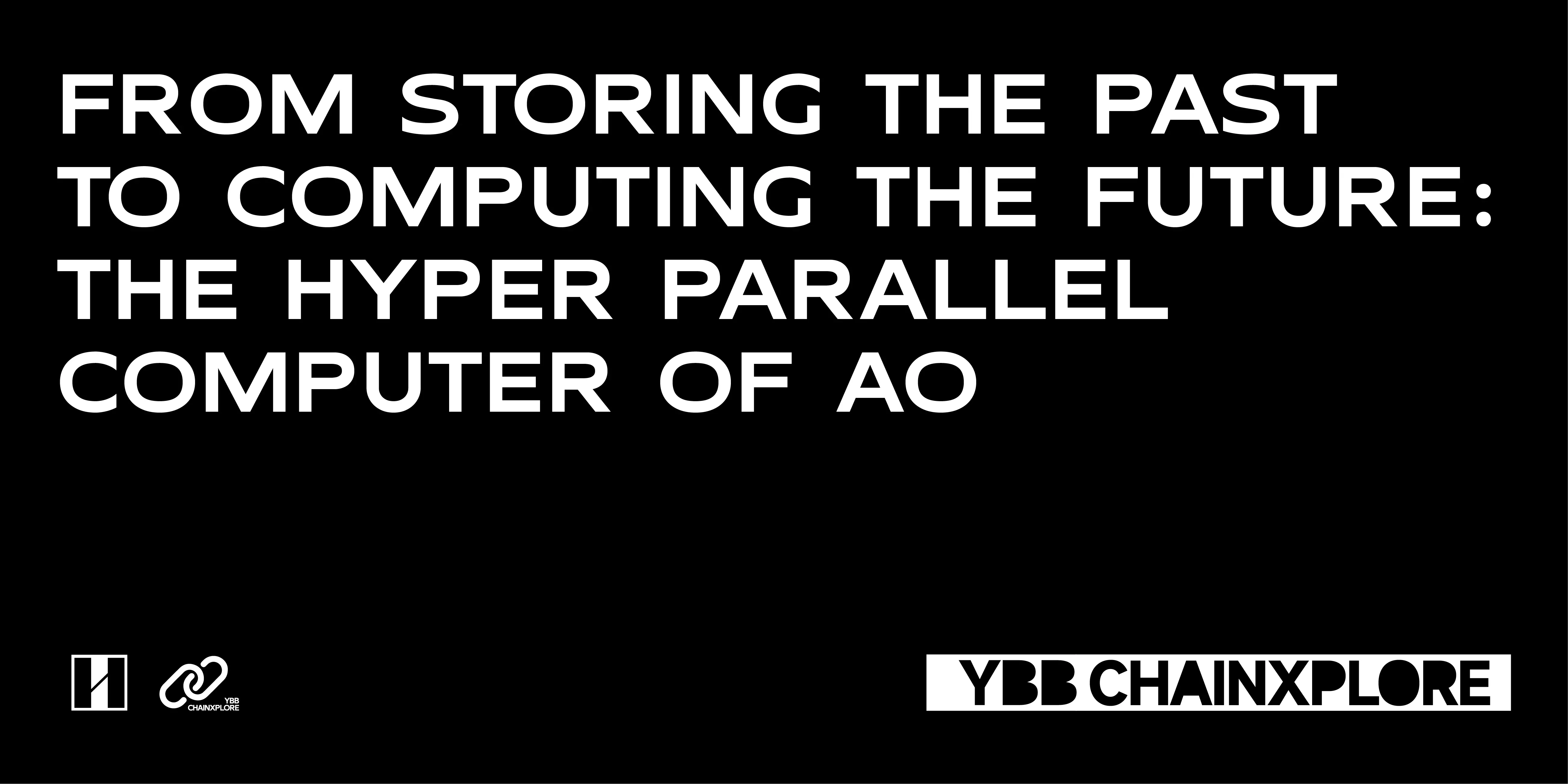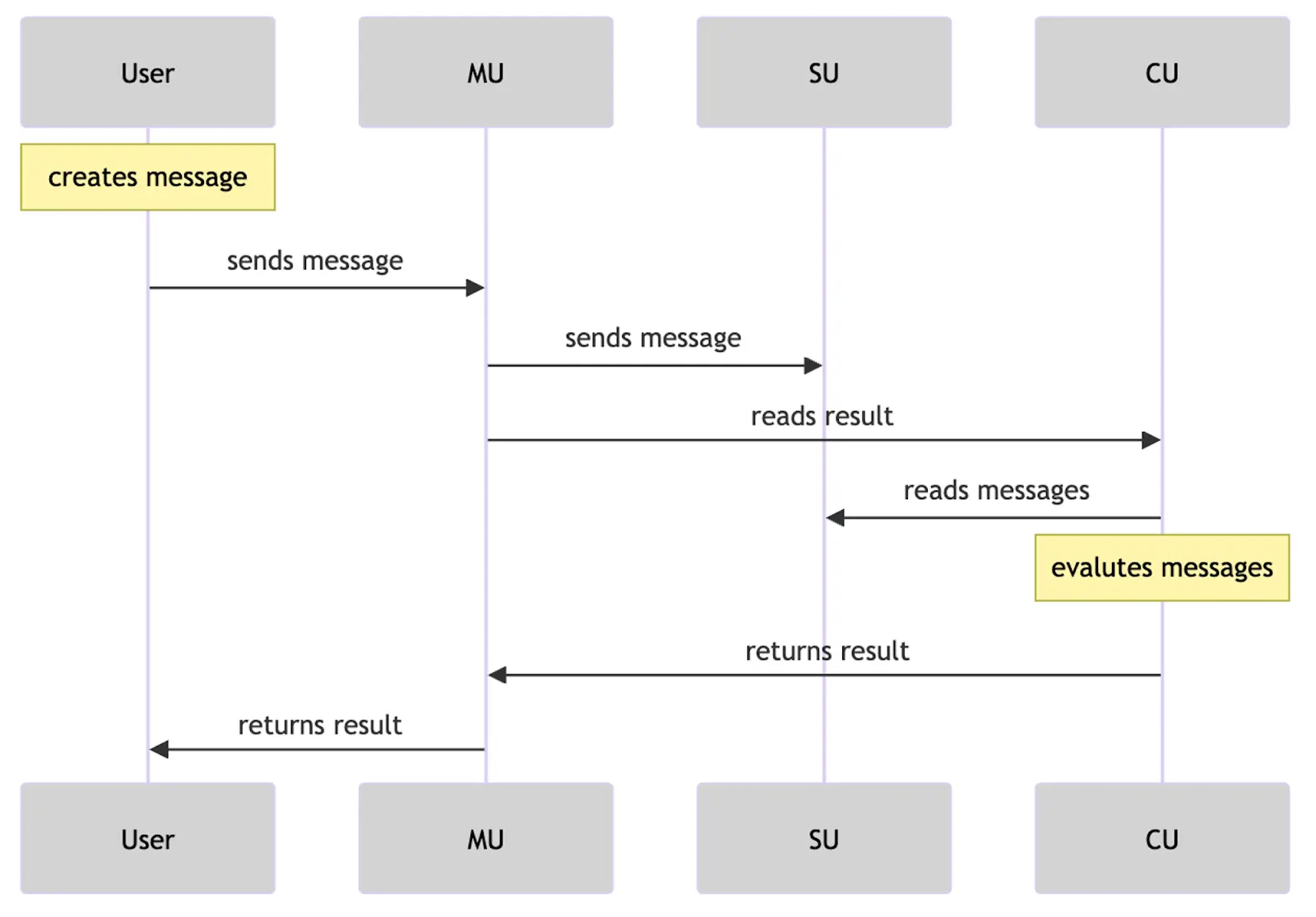From storing the past to calculating the future: AO hyperparallel computer
Author: YBB Capital Researcher Zeke
Preface
Web3 is now differentiated The design of the two mainstream blockchain architectures has inevitably caused some aesthetic fatigue. Whether it is the rampant modular public chain or the new L1 that always emphasizes performance but fails to reflect the performance advantages, its ecology can be said to be a negative impact on Ethereum. Ecological reproduction or slight improvement, and extremely homogeneous experience have long made users lose their sense of freshness. The latest AO protocol proposed by Arweave is eye-catching, achieving ultra-high-performance computing on the storage public chain and even achieving a quasi-Web2 experience. This seems to be hugely different from the expansion methods and architectural design we are currently familiar with. So what exactly is AO? Where does the logic to support its performance come from?
How to understand AO
The name of AO comes from the abbreviation of Actor Oriented, a programming paradigm in the concurrent computing model Actor Model, and its overall design The idea originates from the extension of Smart Weave, and also follows the concept of Actor Model with message passing as its core. Simply put, we can understand AO as a "supercomputer" through message passing and data processing. From an implementation perspective, AO is actually not our common modular execution layer, but a communication protocol that standardizes message passing and data processing. The core goal of the protocol is to enable collaboration between different "actors" within the network through information transfer. This enables a collaborative network with infinitely enhanced performance, centralized cloud-level speed, scalable computing power, and scalability. The protocol has the speed, scalable computing power and scalability of different centralized cloud levels in a communication environment. Finally, a giant hard drive is realized that can have centralized cloud-level speed, scalable computing power and scalability in a decentralized cloud environment.
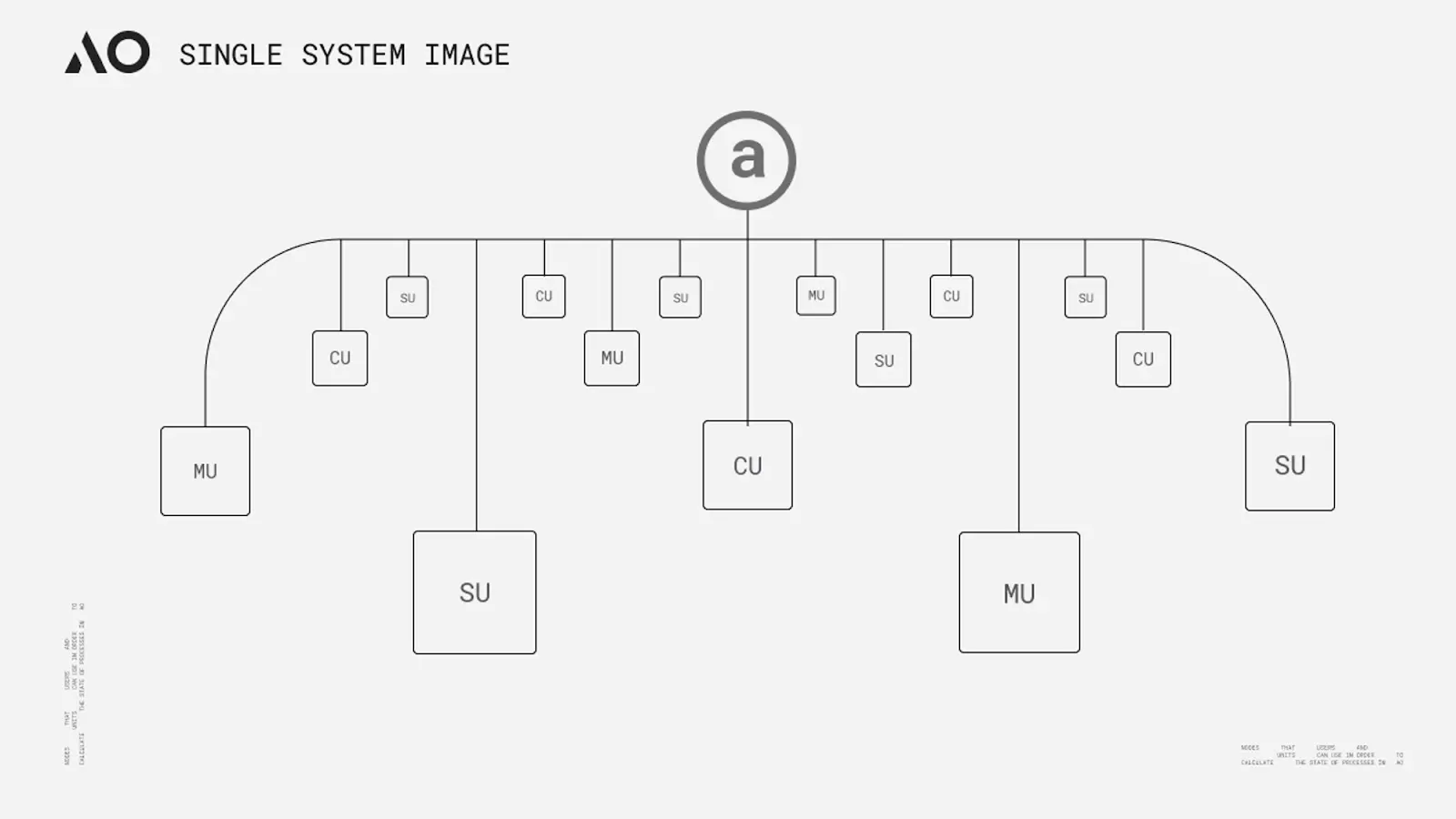
AO’s architecture
AO’s philosophy looks similar to what Gavin Wood said at last year’s Polkadot Decoded conference The proposed "Core Time" segmentation and recombination are somewhat similar. Both of them achieve the so-called "high-performance world computer" through the scheduling and coordination of computing resources. However, there are some essential differences between the two. Exotic Scheduling is the deconstruction and reorganization of the relay chain space resources. It has not changed much to the architecture of Polkadot. The computing performance naturally breaks through the slot model. The upper limit of one parachain is still limited by Polkadot’s maximum number of cores. In theory, AO can complete the sorting, scheduling and calculation of information through node data processing methods and message expression, and through three network units (subnetworks) at the same time. Its standardization method and the functions of different units depend on the official resource analysis, which can be summarized For the following points:
Process: A process can be regarded as a collection of execution instructions in AO. When the process is initialized, it can define the computing environment it requires, including virtual machine, scheduler, memory requirements and necessary extensions. These processes maintain a "holographic" state (each process data can be independently stored in Arweave's message log. The holographic state will be explained in detail in the "Verifiable Issues" section below). The holographic state means that the process can Works independently, and execution is dynamic and can be performed by appropriate computing units. In addition to receiving messages from user wallets, processes can also forward messages from other processes through the messenger unit;
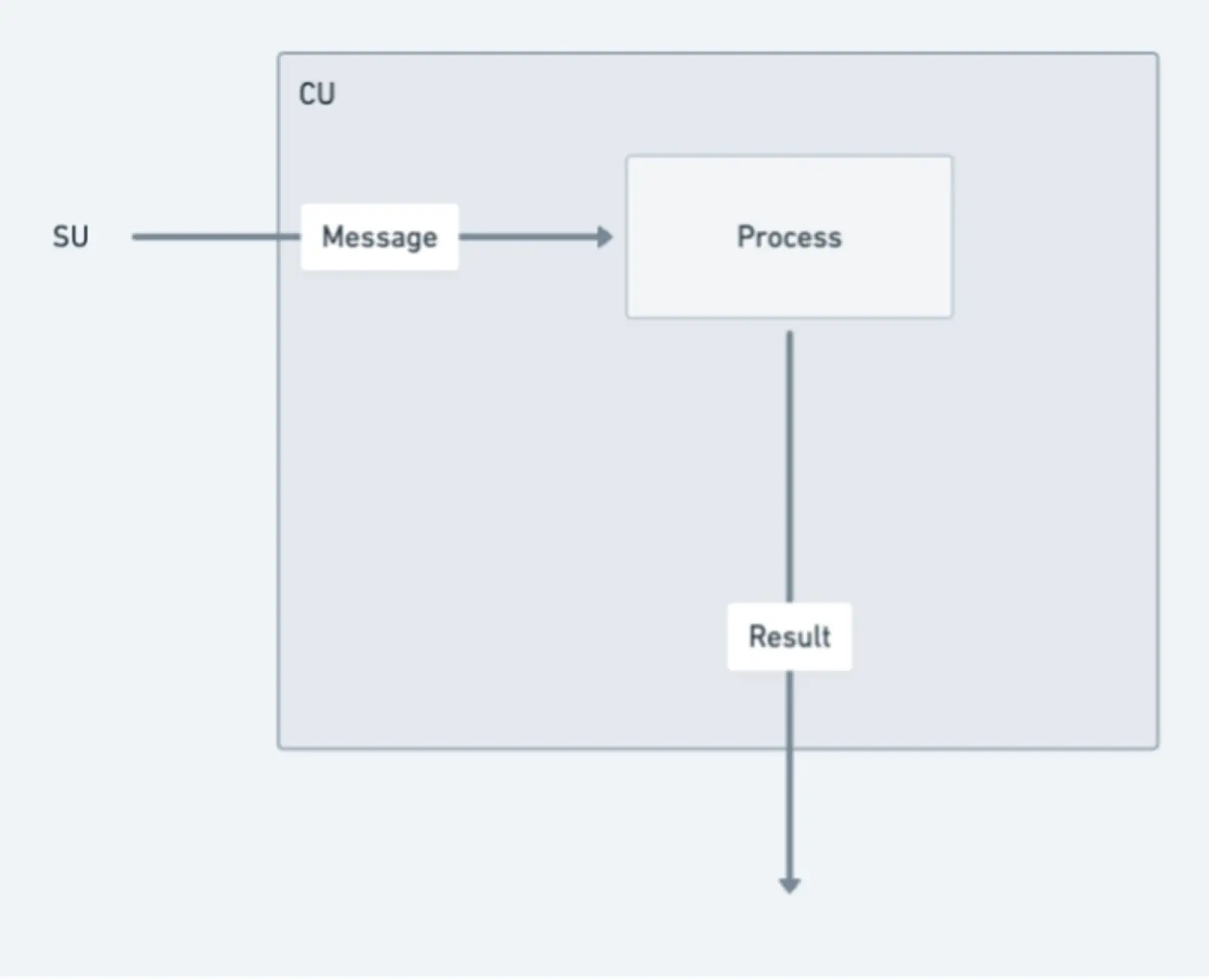
Message: Every interaction between a user (or other process) and the process is represented by a message. The message must conform to Arweave's native ANS-104 data items to maintain a consistent native structure. , so that Arweave can save information. From a more understandable perspective, the message is somewhat similar to the transaction ID (TX ID) in the traditional blockchain, but the two are not exactly the same;
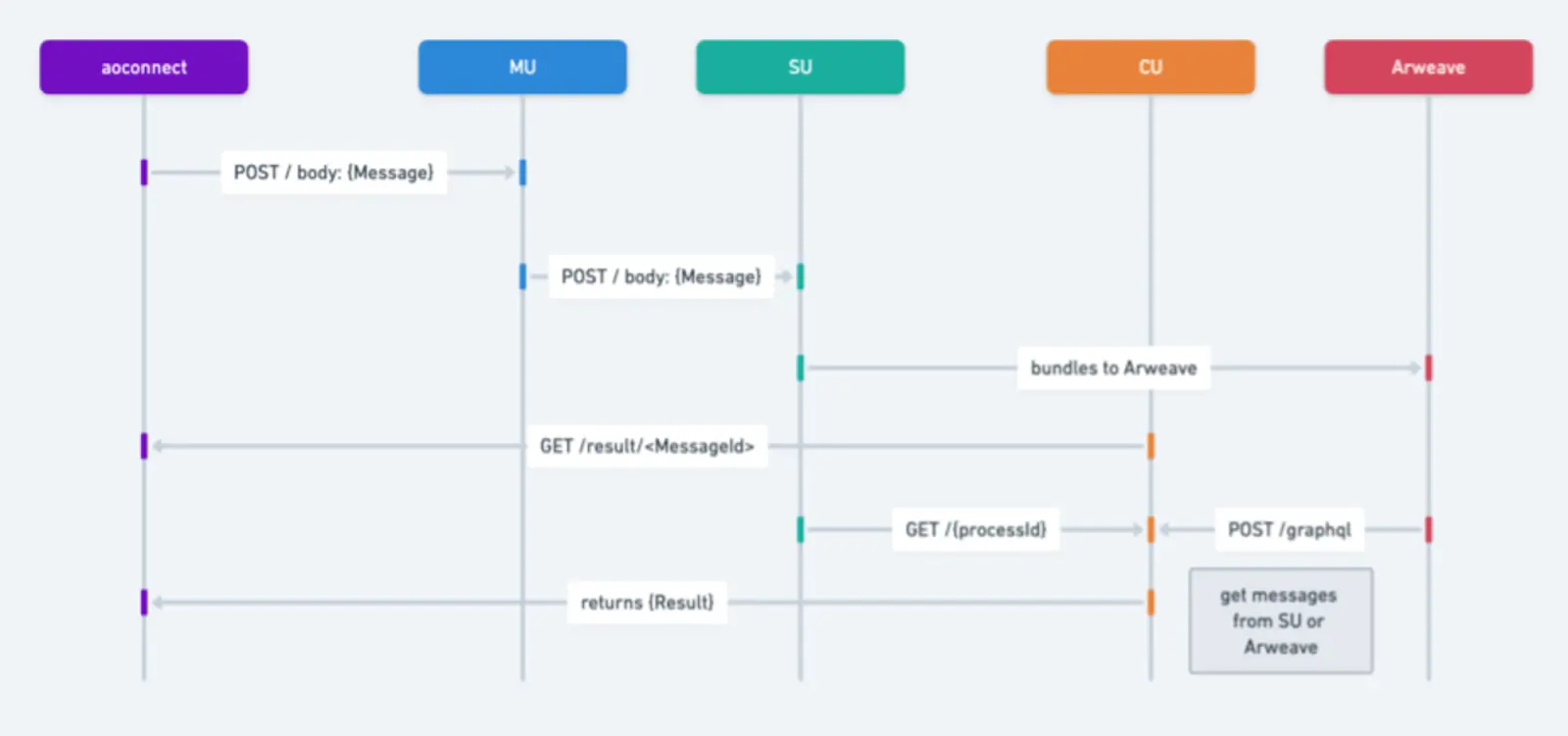
Messenger Unit (MU): The MU relays messages through a process called 'cranking' and is responsible for the delivery of communications in the system to Ensure seamless interaction. Once a message is sent, the MU routes it to the appropriate destination (SU) within the network, coordinating the interaction and recursively processing any resulting outbox messages. This process continues until all messages have been processed. In addition to message relay, the MU provides a variety of functions, including managing process subscriptions and handling scheduled cron interactions;
Scheduler Unit (SU):When receiving a message, SU will initiate a series of key operations to maintain the continuity and integrity of the process. Upon receipt of a message, the SU assigns a unique increment nonce to ensure ordering relative to other messages in the same process. This allocation process is formalized through cryptographic signatures, guaranteeing authenticity and sequence integrity. To further improve the reliability of the process, SU uploads signature assignments and messages into the Arweave data layer. This ensures the availability and immutability of messages and prevents data tampering or loss; A peer-to-peer computing market competes with each other to complete the service of users and SU to resolve the computing process status. Once the state calculation is completed, CU returns a signed certificate with the specific message result to the caller. In addition, CU can also generate and publish signature status certificates that other nodes can load, of course this also requires paying a certain percentage of fees.
-
Operating system AOS
AOS can be regarded as the operating system or terminal tool in the AO protocol, which can be used to download, run and manage threads. It provides an environment in which developers can develop, deploy and run applications. On AOS, developers can use the AO protocol to develop and deploy applications and interact with the AO network.
Operating logic
Actor Model advocates a philosophical view called "everything is an actor". All components and entities within this model can be regarded as "actors". Each actor has its own state, behavior and mailbox. They communicate and collaborate through asynchronous communication, allowing the entire system to operate in a distributed manner. and organize and run in a concurrent manner. The same is true for the operating logic of the AO network. Components and even users can be abstracted as "actors" and communicate with each other through the message passing layer, so that processes are linked to each other. A distributed work system that can be calculated in parallel and has no shared state is intertwined. was established.

The following is a brief description of the steps of the information transfer flow chart:
Message initiation:
Users or processes create messages to send requests to other processes.
The MU (messenger unit) receives the message and sends it to other services using a POST request.
Message processing and forwarding:
MU handles POST requests and forwards messages to SU (Scheduling Unit).
SU interacts with the Arweave storage or data layer to store messages.
Retrieve results based on message ID:
CU (Compute) receives the GET request, retrieves the results based on the message ID, and evaluates the message's status on the process. It can return results based on a single message identifier.
Retrieve information:
# #SU receives a GET request and retrieves message information based on the given time range and process ID.
Push outbox message :
- ##The final step is to push all outbox messages.
- #This step involves checking the message and generation in the result object.
- #Based on the results of this check, steps 2, 3, and 4 can be repeated for each relevant message or build.
Differences from common networks:
- Parallel processing capability
: with Unlike networks such as Ethereum, where the base layer and each Rollup actually run as a single process, AO supports any number of processes running in parallel while ensuring that the verifiability of the computation remains intact. Furthermore, these networks operate in a globally synchronized state, while the AO processes maintain their own independent state. This independence enables the AO process to handle higher numbers of interactions and computational scalability, making it particularly suitable for applications that require high performance and reliability;
- Verifiable Reproducibility
: While some decentralized networks, such as Akash and the peer-to-peer system Urbit, do provide large-scale computing power, unlike AO, they do not Verifiable reproducibility of interactions, or rely on non-persistent storage solutions to save their interaction logs.
The difference between AO's node network and traditional computing environment:
Compatibility: AO supports various Form threads, whether based on WASM or EVM, can be connected to AO through certain technical means.
Content co-creation projects: AO also supports content co-creation projects. You can publish atomic NFT on AO, upload data and combine it with UDL to build it on AO. NFT.
Data composability: NFT on AR and AO can achieve data composability, allowing an article or content to be shared and displayed on multiple platforms at the same time Maintain the consistency and original properties of data sources. When content is updated, the AO network can broadcast these update statuses to all relevant platforms to ensure synchronization of content and dissemination of the latest status.
Value feedback and ownership: Content creators can sell their works as NFTs and transfer ownership information through the AO network to realize value feedback for the content.
Support for the project:
Built based on Arweave: AO utilizes the features of Arweave , eliminating the vulnerabilities associated with centralized providers such as single points of failure, data breaches, and censorship. Computations on AO are transparent and can be verified through decentralized trust minimization features and reproducible message logs stored on Arweave;
Decentralized Foundation: AO’s decentralized foundation helps overcome scalability limitations imposed by physical infrastructure. Anyone can easily create an AO process from their terminal, with no need for specialized knowledge, tools or infrastructure, ensuring that even individuals and small-scale entities can have global reach and participation.
Verifiable problems of AO
After we understand the framework and logic of AO, there is usually a Common problem. AO does not seem to have the global characteristics of traditional decentralized protocols or chains. Can it achieve verifiability and decentralization just by uploading some data to Arweave? ? In fact, this is the mystery of AO design. AO itself is an off-chain implementation and does not solve the issue of verifiability or change the consensus. The idea of the AR team is to separate the functions of AO and Arweave and then connect them in a modular manner. AO only performs communication and calculation, and Arweave only provides storage and verification. The relationship between the two is more like mapping. AO only needs to ensure that the interaction log is stored on Arweave, and its state can be projected to Arweave to create a hologram. This holographic state projection ensures the consistency and reliability of the output when calculating the state. sex, certainty. In addition, the AO process can be reversely triggered to perform specific operations through the message log on Arweave (it can wake up on its own according to preset conditions and schedules, and perform corresponding dynamic operations).
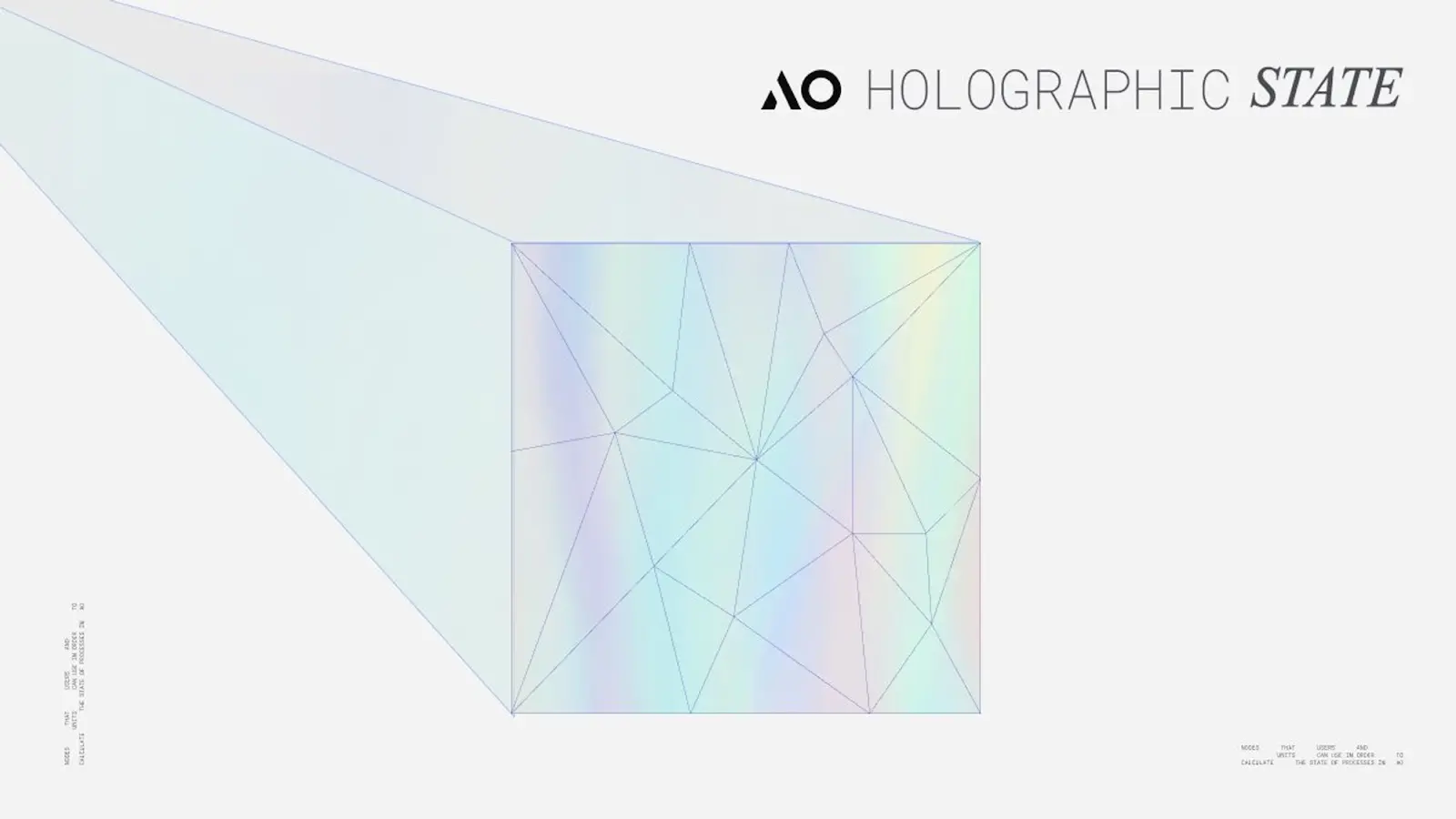
According to what Hill and Outprog shared, if the verification logic is simpler, then AO can be imagined as aInscription calculation framework based on super-parallel indexer. We all know that the Bitcoin inscription indexer needs to extract JSON information from the inscription to verify the inscription, record the balance information in the off-chain database, and complete the verification through a set of indexing rules. Although the indexer is verified off-chain, users can verify the inscription by changing multiple indexers or running the index themselves, so there is no need to worry about the indexer doing evil. We mentioned above that data such as the sorting of messages and the holographic status of the process are uploaded to Arweave. Then it only needs to be based on the SCP paradigm (storage consensus paradigm. Here it can be simply understood that SCP is the indexer of the indexing rules on the chain. In addition It is worth noting that SCP appeared much earlier than the indexer), and anyone can restore AO or any thread on AO through the holographic data on Arweave. Users do not need to run the whole node to verify the trusted status. Just like changing the index, users only need to make query requests to single or multiple CU nodes through SU. Arweave has high storage capacity and low cost, so under this logic, AO developers can implement a supercomputing layer that far exceeds the functions of Bitcoin inscriptions.
AO and ICP
Let’s use some keywords to summarize the characteristics of AO: giant native hard disk, unlimited parallelism, unlimited computing , modular overall architecture and holographic state processes. All this sounds very good, but friends who are familiar with various public chain projects in the blockchain may find that AO is particularly similar to a "Death-level" project, which is the once popular "Internet Computer" ICP.
ICP was once hailed as the last king-level project in the blockchain world. It was highly favored by top institutions and reached 200 billion US dollars in 21 years of crazy bulls. FDV. But as the wave receded, ICP’s token value also plummeted. Until the 2023 bear market, the value of ICP tokens had dropped nearly 260 times compared to its historical high. However, if the performance of Token price is not considered, even if ICP is re-examined at this time, its technical features still have many unique features. Many of the amazing advantages and features of AO today were also possessed by ICP back then. So will AO fail like ICP? Let’s first understand why the two are so similar. ICP and AO are both designed based on Actor Model and focus on locally running blockchains, so the characteristics of the two have many similarities. The ICP subnet blockchain is formed by a number of independently owned and controlled high-performance hardware devices (node machines) that run the Internet Computer Protocol (ICP). The Internet Computer Protocol is implemented by a number of software components, which as a bundle are replicas in that they replicate state and computation across all nodes in a subnet blockchain.
ICP’s replication architecture can be divided into four layers from top to bottom:
Peer-to-Point (P2P) Network Layer : Used to collect and notify messages from users, other nodes in their subnet blockchain, and other subnet blockchains. Messages received by the peer layer will be replicated to all nodes in the subnet to ensure security, reliability and resiliency;
Consensus Layer: Selects and sorts messages received from users and different subnets to create blockchain blocks that can be used to form the evolving blockchain Byzantine fault tolerant consensus is notarized and finalized. These finalized blocks are passed to the message routing layer;
Message Routing Layer: Used for routing user and system generated messages between subnets, management Dapp’s input and output queues and arranges message execution;
Execution environment layer: Calculate the time required to execute the smart contract by processing the messages received from the message routing layer Deterministic calculations involved.
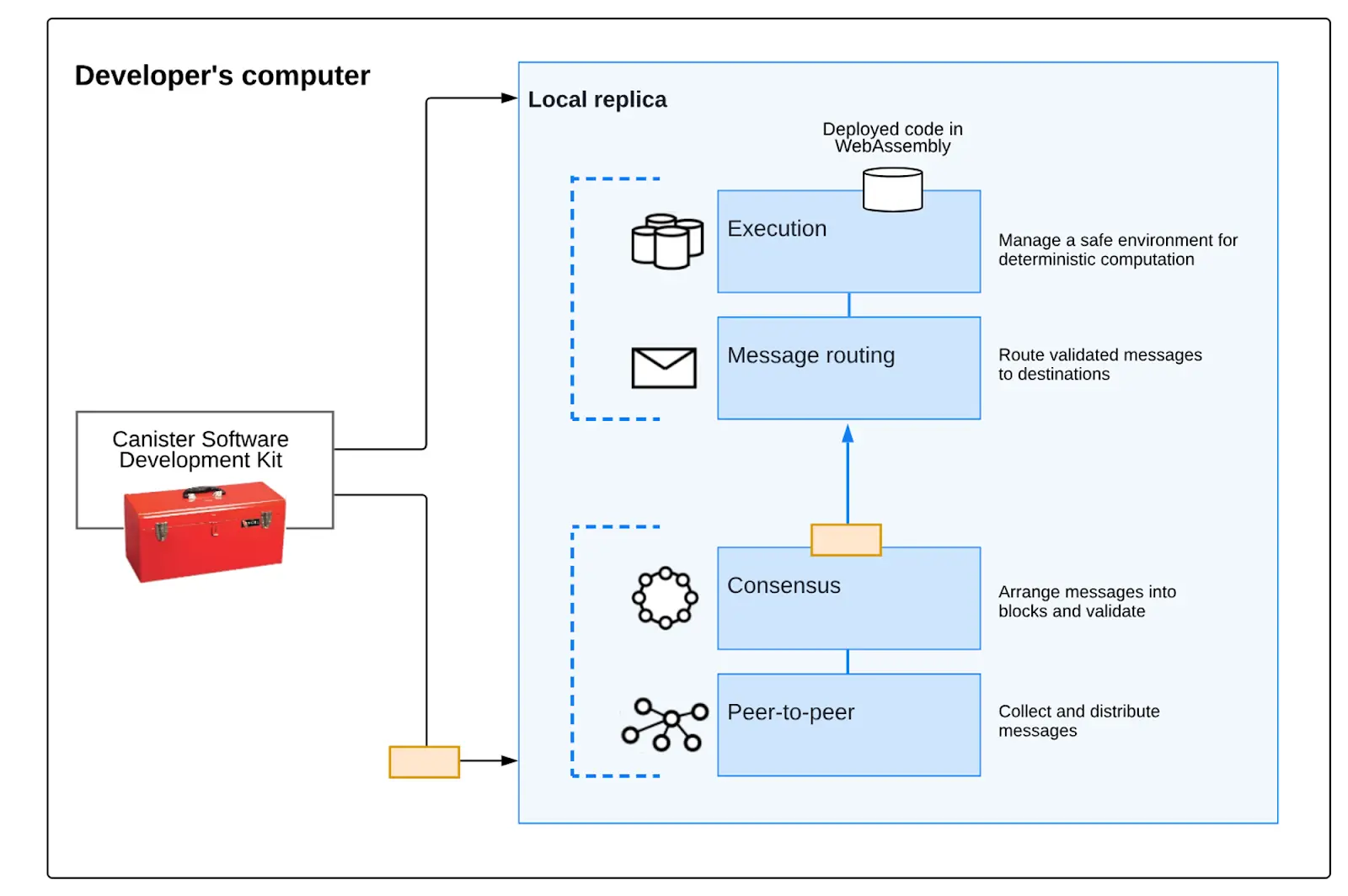
Subnet Blockchain
The so-called subnet is a collection of interacting copies. These copies Run a separate instance of the consensus mechanism in order to create your own blockchain on which a set of "containers" can run. Each subnet can communicate with other subnets and is controlled by the root subnet, which uses chain key cryptography to delegate its permissions to individual subnets. ICP uses subnets to allow it to expand indefinitely. The problem with traditional blockchains (and individual subnets) is that they are limited by the computing power of a single node machine, since each node must run everything that happens on the blockchain in order to participate in the consensus algorithm. Running multiple independent subnets in parallel allows ICP to break through this single-machine barrier.
Why it failed
As mentioned above, the purpose that the ICP architecture wants to achieve is simply a decentralized cloud server. A few years ago, this idea was as shocking as AO, but why did it fail? To put it simply, it means that if you don’t succeed at the high level, you won’t settle at the low level. You haven’t found a good balance between Web3 and your own ideas, which ultimately leads to the embarrassing situation that the project is neither Web3 nor as easy to use as the centralized cloud. In summary, there are three problems. point. First, ICP's program system Canister, the "container" mentioned above, is actually somewhat similar to AOS and processes in AO, but they are not the same. ICP programs are implemented by Canister encapsulation and are not visible to the outside world. They need to access data through specific interfaces. Asynchronous communication is very unfriendly to contract calls in DeFi protocols, so in DeFi Summer, ICP did not capture the corresponding financial value.
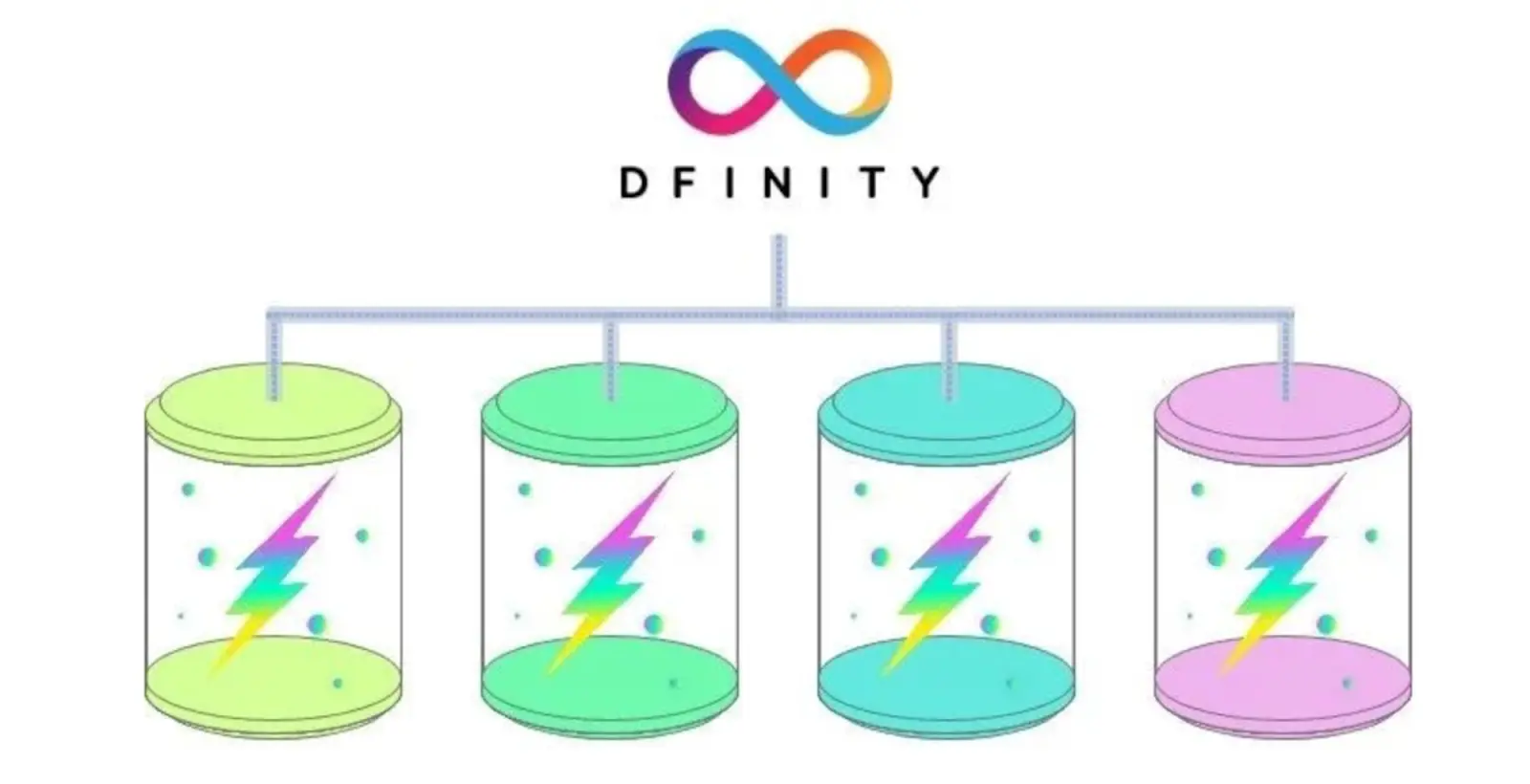
The second point is that the hardware requirements are extremely high, resulting in the project not being decentralized. The following figure is the minimum hardware configuration of the node given by ICP at that time The picture is very exaggerated even now, far exceeding the configuration of Solana, and even the storage requirements are higher than the storage public chain.
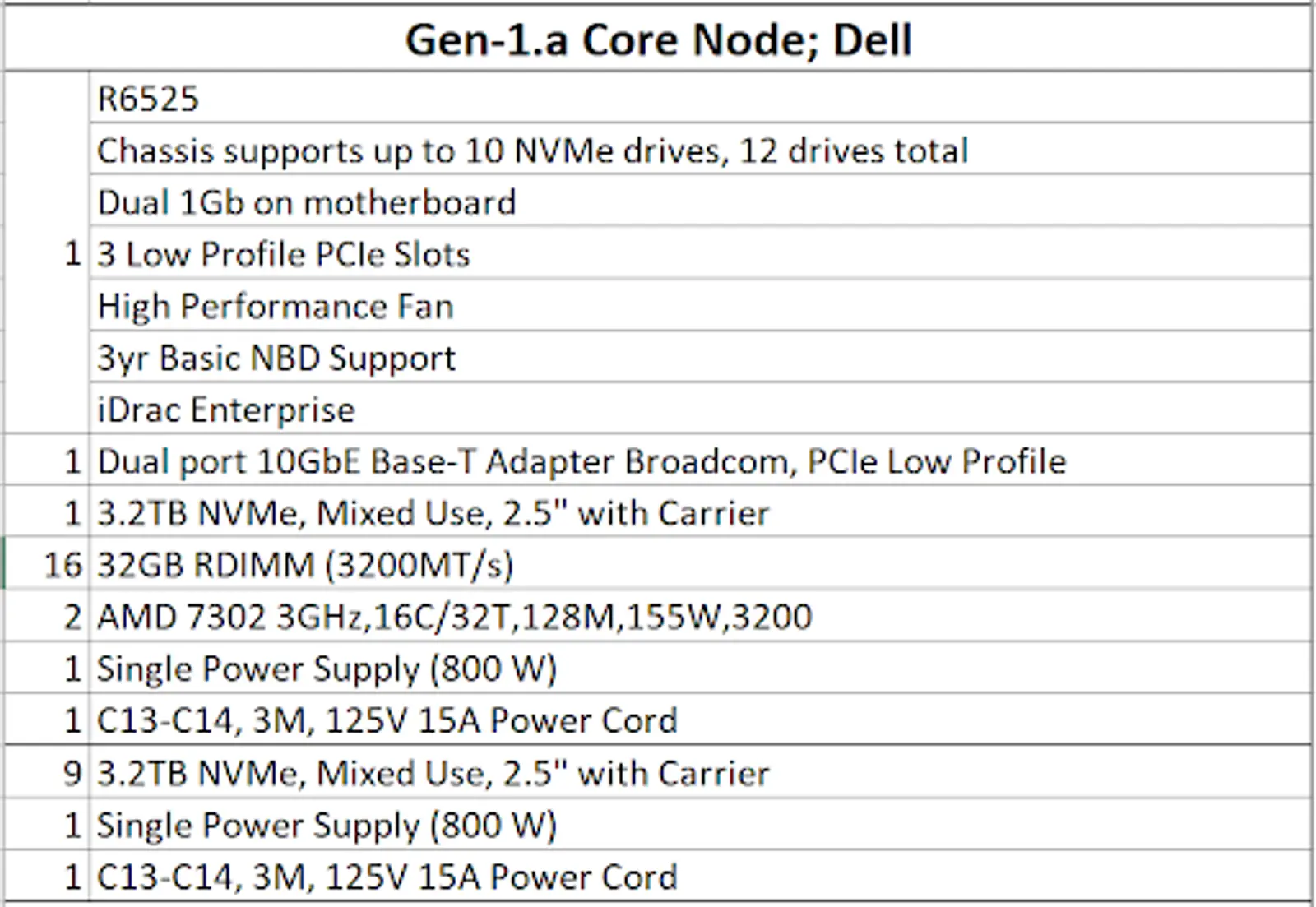
#The third point is the lack of ecology. Even now, ICP is a very high-performance public chain. If there are no DeFi applications, what about other applications? Sorry, ICP has not produced a killer application since its inception. Its ecosystem has neither captured Web2 users nor Web3 users. After all, with so little decentralization, why not just use rich and mature centralized applications? But in the end, it is undeniable that ICP’s technology is still top-notch, and its advantages of reverse gas, high compatibility, and unlimited expansion are still necessary to attract the next billion users. Under the current AI wave, if ICP can be good at It may be possible to turn over using its own structural advantages.
So back to the question above, will AO fail like ICP? I personally think that AO will not repeat the same mistakes. The last two points that led to the failure of ICP in the first place are not problems for AO. Arweave already has a good ecological foundation. Holographic state projection also solves the centralization problem. In terms of compatibility, AO Also more flexible. More challenges may focus on the design of the economic model, support for DeFi, and a century-old problem: In the non-financial and storage fields, what form should Web3 take?
Web3 should not stop at narrative
The most frequent occurrence in the world of Web3 Words must be "narratives", and we have even become accustomed to using narrative perspectives to measure the value of most tokens. This naturally stems from the dilemma that most Web3 projects have great vision but are very embarrassing to use. In comparison, Arweave already has many fully implemented applications, and they all target Web2-level experience. For example, Mirror and ArDrive. If you have used these projects, it will be difficult to feel the difference from traditional applications. However, Arweave still has great limitations in value capture as a storage public chain, and calculation may be the only way to go. Especially in today's external world, AI has become a general trend. There are still many natural barriers to the integration of Web3 at this stage, which we have also talked about in past articles. Now Arweave's AO uses a non-Ethereum modular solution architecture, giving Web3 x AI a good new infrastructure. From the Library of Alexandria to super-parallel computers, Arweave is following a paradigm of its own.
Reference article
##AO Quick Start: Introduction to Super Parallel Computers: https://medium.com/@permadao/ao-Quick Start-Introduction to Super Parallel Computers-088ebe90e12f
X Space Activity Record|AO is Rather than being an Ethereum killer, how will it drive a new narrative for blockchain? :https://medium.com/@permadao/x-space-Activity Record-ao-Is it an Ethereum killer-How will it promote the new narrative of the blockchain-bea5a22d462c
ICP White Paper: https://internetcomputer.org/docs/current/concepts/subnet-types
AO CookBook:https://cookbook_ao.arweave.dev/concepts/tour.html
AO — — Hyperparallel computers you can’t imagine: https://medium.com/@permadao/ao-You can’t imagine Hyperparallel Computer-1949f5ef038f
Multi-angle analysis of the reasons for the decline of ICP: unique technology and thin ecosystem: https: //www.chaincatcher.com/article/2098499
The above is the detailed content of From storing the past to calculating the future: AO hyperparallel computer. For more information, please follow other related articles on the PHP Chinese website!

Hot AI Tools

Undresser.AI Undress
AI-powered app for creating realistic nude photos

AI Clothes Remover
Online AI tool for removing clothes from photos.

Undress AI Tool
Undress images for free

Clothoff.io
AI clothes remover

Video Face Swap
Swap faces in any video effortlessly with our completely free AI face swap tool!

Hot Article

Hot Tools

Notepad++7.3.1
Easy-to-use and free code editor

SublimeText3 Chinese version
Chinese version, very easy to use

Zend Studio 13.0.1
Powerful PHP integrated development environment

Dreamweaver CS6
Visual web development tools

SublimeText3 Mac version
God-level code editing software (SublimeText3)

Hot Topics
 1663
1663
 14
14
 1420
1420
 52
52
 1315
1315
 25
25
 1266
1266
 29
29
 1239
1239
 24
24
 What kind of software is a digital currency app? Top 10 Apps for Digital Currencies in the World
Apr 30, 2025 pm 07:06 PM
What kind of software is a digital currency app? Top 10 Apps for Digital Currencies in the World
Apr 30, 2025 pm 07:06 PM
With the popularization and development of digital currency, more and more people are beginning to pay attention to and use digital currency apps. These applications provide users with a convenient way to manage and trade digital assets. So, what kind of software is a digital currency app? Let us have an in-depth understanding and take stock of the top ten digital currency apps in the world.
 Quantitative Exchange Ranking 2025 Top 10 Recommendations for Digital Currency Quantitative Trading APPs
Apr 30, 2025 pm 07:24 PM
Quantitative Exchange Ranking 2025 Top 10 Recommendations for Digital Currency Quantitative Trading APPs
Apr 30, 2025 pm 07:24 PM
The built-in quantization tools on the exchange include: 1. Binance: Provides Binance Futures quantitative module, low handling fees, and supports AI-assisted transactions. 2. OKX (Ouyi): Supports multi-account management and intelligent order routing, and provides institutional-level risk control. The independent quantitative strategy platforms include: 3. 3Commas: drag-and-drop strategy generator, suitable for multi-platform hedging arbitrage. 4. Quadency: Professional-level algorithm strategy library, supporting customized risk thresholds. 5. Pionex: Built-in 16 preset strategy, low transaction fee. Vertical domain tools include: 6. Cryptohopper: cloud-based quantitative platform, supporting 150 technical indicators. 7. Bitsgap:
 Is the digital currency app formal? Top 10 formal and legal virtual currency trading apps in the world
Apr 30, 2025 pm 07:09 PM
Is the digital currency app formal? Top 10 formal and legal virtual currency trading apps in the world
Apr 30, 2025 pm 07:09 PM
Recommended cryptocurrency trading platforms include: 1. Binance: the world's largest trading volume, supports 1,400 currencies, FCA and MAS certification. 2. OKX: Strong technical strength, supports 400 currencies, approved by the Hong Kong Securities Regulatory Commission. 3. Coinbase: The largest compliance platform in the United States, suitable for beginners, SEC and FinCEN supervision. 4. Kraken: a veteran European brand, ISO 27001 certified, holds a US MSB and UK FCA license. 5. Gate.io: The most complete currency (800), low transaction fees, and obtained a license from multiple countries. 6. Huobi Global: an old platform that provides a variety of services, and holds Japanese FSA and Hong Kong TCSP licenses. 7. KuCoin
 How to download, install and register the Hong Kong Digital Currency Exchange app 2025
Apr 30, 2025 pm 07:18 PM
How to download, install and register the Hong Kong Digital Currency Exchange app 2025
Apr 30, 2025 pm 07:18 PM
The download, installation and registration process of the Hong Kong Digital Currency Exchange app is very simple. Users can quickly obtain and use this app through the official app download link provided in this article. This article will introduce in detail how to download, install and register the Hong Kong Digital Currency Exchange app to ensure that every user can complete the operation smoothly.
 How to download the Hong Kong Digital Currency Exchange app? The top ten digital currency exchange apps are included
Apr 30, 2025 pm 07:12 PM
How to download the Hong Kong Digital Currency Exchange app? The top ten digital currency exchange apps are included
Apr 30, 2025 pm 07:12 PM
The methods to download the Hong Kong Digital Currency Exchange APP include: 1. Select a compliant platform, such as OSL, HashKey or Binance HK, etc.; 2. Download through official channels, iOS users download on the App Store, Android users download through Google Play or official website; 3. Register and verify their identity, use Hong Kong mobile phone number or email address to upload identity and address certificates; 4. Set security measures, enable two-factor authentication and regularly check account activities.
 Huobi Digital Currency Trading App Download Official Website. Correct Address. Domestic
Apr 30, 2025 pm 07:21 PM
Huobi Digital Currency Trading App Download Official Website. Correct Address. Domestic
Apr 30, 2025 pm 07:21 PM
Huobi Digital Currency Trading App is one of the world's leading digital asset trading platforms and is favored by the majority of users. In order to facilitate users to quickly and safely download and install Huobi app, this article will provide you with detailed download and installation tutorials. Please note that this article provides a download link to Huobi official app. Use the download link to this article to download safely to avoid mistakenly entering a copycat website or downloading to unofficial versions. Next, let us download and install Huobi app step by step.
 uniswap on-chain withdrawal
Apr 30, 2025 pm 07:03 PM
uniswap on-chain withdrawal
Apr 30, 2025 pm 07:03 PM
Uniswap users can withdraw tokens from liquidity pools to their wallets to ensure asset security and liquidity. The process requires gas fees and is affected by network congestion.
 Is there a future for digital currency apps? Apple mobile digital currency trading platform app download TOP10
Apr 30, 2025 pm 07:00 PM
Is there a future for digital currency apps? Apple mobile digital currency trading platform app download TOP10
Apr 30, 2025 pm 07:00 PM
The prospects of digital currency apps are broad, which are specifically reflected in: 1. Technology innovation-driven function upgrades, improving user experience through the integration of DeFi and NFT and AI and big data applications; 2. Regulatory compliance trends, global framework improvements and stricter requirements for AML and KYC; 3. Function diversification and service expansion, integrating lending, financial management and other services and optimizing user experience; 4. User base and global expansion, and the user scale is expected to exceed 1 billion in 2025.



